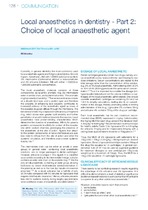| dc.contributor.author | Moodley, Desi | |
| dc.date.accessioned | 2018-07-20T08:38:01Z | |
| dc.date.available | 2018-07-20T08:38:01Z | |
| dc.date.issued | 2017 | |
| dc.identifier.citation | Moodley, D.S. (2017). Local anaesthetics in dentistry - Part 2: Choice of local anaesthetic agent. South African Dental Journal, 72 (3): 128 - 130 | en_US |
| dc.identifier.issn | 7375-1562 | |
| dc.identifier.uri | http://hdl.handle.net/10566/3894 | |
| dc.description.abstract | Currently, in general dentistry the most commonly used
local anaesthetic agents are 2% lignocaine (Xylotox, Adcock
Ingram; Xylesthesin, 3M) with 1:80000 adrenaline content,
3% mepivicaine (Carbocaine) without a vasoconstrictor
and 4% articaine (Ubistesin 3M) with either 1:100000 or
1:200000 adrenaline concentration. | en_US |
| dc.language.iso | en | en_US |
| dc.publisher | SADA | en_US |
| dc.rights | This file may be freely used for educational uses. No commercial reproduction or distribution of this file is permitted without written permission of the South African Dental Association (SADA). Note that SADA retains all intellectual property rights in the article. | |
| dc.subject | Dentistry | en_US |
| dc.subject | Anaesthetics | en_US |
| dc.subject | Local anaesthetics | en_US |
| dc.title | Local anaesthetics in dentistry - Part 2: Choice of local anaesthetic agent | en_US |
| dc.type | Article | en_US |
| dc.privacy.showsubmitter | FALSE | |
| dc.status.ispeerreviewed | TRUE | |

